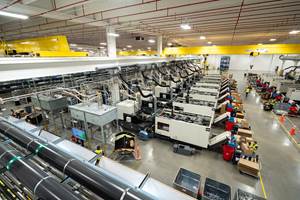Energy Consumption Made Visible
Molder adds system that allows it to track energy usage in nearly real time and is now using less power, despite increased production.
Unlike other variable costs like labor or materials, for most processors the only visibility they have into their power usage is when they tear open the monthly utility bill. Add a shift, and you’re going to notice more people on the shop floor. Run more material, and expect to see more railcars or gaylords coming through the plant.
But use more energy in a given month, and unless you’re keen enough to hear additional motors kicking in, you’ll be none the wiser until you pay the power company.
That was Automation Plastics Corp.’s relationship with its power usage until it contracted with energy-intelligence software and services provider EnerNOC of Boston, Mass. Based outside Cleveland in Aurora, Ohio, Automation Plastics serves a variety of industries as a custom molder, with runs ranging from small, high-cavitation components for aerosol containers to large, thick-walled components for the natural-gas industry.
Operating 33 machines ranging in clamp force from 38 to 500 tons, Automation Plastics’ 50,500-sq-ft operation is big enough to make keeping tabs manually on energy usage difficult, but small enough to feel the impact of any wasted power.
EnerNOC’s service involves installing a pulse meter that takes readings directly off the facility’s main power meter. These readings are then sent via a cellular connection to EnerNOC’s cloud-based software, which interprets the data and allows users like Automation to assess usage and set alarms in real time. That immediacy has an obvious benefit, according to Jerome Smith, Automation’s sales and engineering manager.
“You get that information nearly real time,” Smith says, “not when you get the next bill. Otherwise, it’s 30 days later and you realize, ‘Hey, we used 10% more energy this month, and we ran fewer machines—what happened?’ This way, you can find out in real time when it’s going on and maybe nip it in the bud.”
For Chris Miller, manufacturing engineer at Automation Plastics, a deeper dive into EnerNOC’s readings has become part of his regular routine. “I’ve got it on my calendar on Outlook to go in every Monday, and just kind of review,” Miller says, noting that alerts are sent for anything requiring immediate attention. “I can see if there’s any funny stuff going on or if things seem pretty normal.”
After several years of accessing EnerNOC’s data, Automation has used the insights it offered into its power usage to revamp its machine fleet. In particular, seeing the energy usage of all-electric and hybrid machines vs. hydraulics has created “a huge incentive to replace our equipment and update our facility,” Miller notes. The firm has replaced hydraulic machines with all-electrics and hybrids.
“We’re using less energy, we’re running more production and we’ve got more going on than we did five or six years ago,” Miller says, “and we’re still paying the same amount of money for our electric bill.”
In terms of operations, Miller notes that EnerNOC has made Automation Plastics much more vigilant in its shutdown procedures now that it can see, for instance, the effect of leaving a blower on over the weekend. From a management perspective, it has made energy usage more palpable to the molder.
“One thing EnerNOC does do is make you a lot more analytical about how your plant is running,” Miller says. “You learn what’s going on.”
Related Content
LyondellBasell Showcasing End-Use Applications in 5 Key Markets
NPE2024: LYB is highlighting applications in circularity, mobility and transportation, food and medical, consumer goods/lifestyle, and infrastructure/building and construction.
Read MoreNova Makes Senior Leadership Changes
The company’s aim is to bolster sustainability ambitions
Read MoreIPEX Opens Injection Molding Facility in North Carolina
The pipe and fittings manufacturer’s new 200,000-square-foot facility represents a $200 million investment and will create 150 jobs.
Read MoreArchitectural Mesh Made from Covestro’s Bioattributed PC
Kaynemaile’s new RE8 Architectural Mesh will deliver an ISCC Plus certified sustainable share of up to 88% of its architectural product.
Read MoreRead Next
Beyond Prototypes: 8 Ways the Plastics Industry Is Using 3D Printing
Plastics processors are finding applications for 3D printing around the plant and across the supply chain. Here are 8 examples to look for at NPE2024.
Read MoreSee Recyclers Close the Loop on Trade Show Production Scrap at NPE2024
A collaboration between show organizer PLASTICS, recycler CPR and size reduction experts WEIMA and Conair recovered and recycled all production scrap at NPE2024.
Read More

















